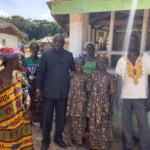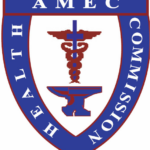By Rev. Mycal X. Brickhouse
We live in perilous times. War displaces families from their homes. Famine starves communities already battered by poverty. Cruel political policies separate children from their parents.
We are surrounded by pain, yet we have lost our sight—not our physical vision, but our spiritual sensitivity. We see affliction so often that we forget to see it through the eyes of Jesus. Our familiarity with suffering breeds apathy. We witness people’s pain without recognizing their humanity.
Acts 3 provides a powerful portrait of recovering our sight—not just through miraculous healing but also by learning to see others rightly. A man, lame from birth, is laid at the Temple gate called Beautiful. Every day, he begs for help. Each day, people walk past him to pray, never considering that he, too, might long to pray. He has become part of the scenery, a fixture of brokenness they have learned to ignore.
We are not so different.
This man represents many in our society who are rendered invisible by circumstance. Today, we see modern parallels: the refugee family fleeing war, only to be turned away at borders; the unhoused veteran sleeping outside the very institutions he once served to protect; the single mother choosing between rent and medicine; the teen facing systemic racism in a school that labels him before knowing his name; the child in Gaza who does not know life without bombings; the incarcerated man serving a life sentence for a crime committed as a child.
These individuals are not statistics. They are not conditions; they are people—image-bearers of God—yet their humanity often goes unseen.
The lame man in Acts 3 had been coming to the Temple for years. Though we do not know his name, his routine was familiar: he was carried by others, placed at the gate, and left to beg. The gate was called Beautiful, but for him, it was a daily reminder of exclusion. He could approach the place of worship but never enter. Cultural beliefs viewed his disability as a sign of sin or divine punishment. He was judged by his condition, with assumptions made about his worthiness.
This theological misreading—equating suffering with sin—still haunts us. Too often, we look at people’s hardships and wonder: What did they do to deserve this? We are more inclined to blame than to bless.
But Peter and John offer us a different response. As they approach the temple, they do something radical: they stop. They say to the man, “Look at us.” And in that moment, everything changes.
The man looks at them, expecting coins, but he receives a miracle. Peter says, “Silver and gold I do not have, but what I do have I give you. In the name of Jesus Christ of Nazareth, rise and walk.” Then, Peter takes him by the hand and lifts him up, and immediately, the man’s feet and ankles are strengthened. He doesn’t just stand—he walks, leaps, and enters the temple, praising God.
This healing transcends physical restoration; it symbolizes the restoration of sight for everyone involved. Peter and John see the man as a person, not a project. They recognize his potential, not just his pain. They didn’t merely perform a miracle—they entered into a relationship. The miracle occurred not in isolation, but through seeing, touching, speaking, and lifting.
This is what it means to see with the eyes of Christ.
In a world filled with suffering, the temptation is to avert our gaze. We walk past the wounded, believing we have nothing to offer. Or worse, we assume those wounded are beyond help. But Acts 3 reminds us that what people need most is not always what they ask for. The lame man asked for coins; he received connection, compassion, and community.
And here’s the truth: spiritual blindness is not just a lack of insight; it’s a refusal to engage. It is easier to throw coins at problems than to see Christ in those who suffer.
Our faith must compel us to look again.
We need to look at the family facing eviction and see not irresponsibility but a system that fails the working poor. We must look at a person struggling with addiction and see not weakness but unresolved trauma and deep longing. We ought to see those crossing borders not as threats but as sacred stories of survival. We must remember that the gospel we preach is one of liberation, transformation, and grace when looking at incarcerated individuals. We should view war not merely as an abstract political reality but as a devastating wound on the body of humanity, where children are buried under rubble, where parents weep without comfort, and where entire communities are erased before the world can even learn their names.
The recovery of sight in Acts 3 also serves as an indictment. The people who passed by this man every day had grown blind to him. They entered the temple to pray while stepping over the suffering at the gate. The religious rhythm continued—but without love, justice, or mercy.
This raises the question: Are we any different? Do our churches have beautiful gates and blind congregations? Do we bring offerings but forget to see those in need?
The good news is this: sight can be restored. If we are willing to pause, to pay attention, to truly see—then healing can happen.
So, I ask you today: Are you willing to see?
See Jesus in the suffering. See Jesus in the places of pain. See Jesus in the eyes of the wounded and the weary. See Jesus—and then be Christ to those who are crying out. Because when we look and live, we make space for others to rise. When we see rightly, we lift differently. When we love deeply, we heal holistically. Let us recover our sight. Let us stop at the gate. Let us say to the world, with holy conviction: “Look and live. Look to Jesus, now, and live!”





